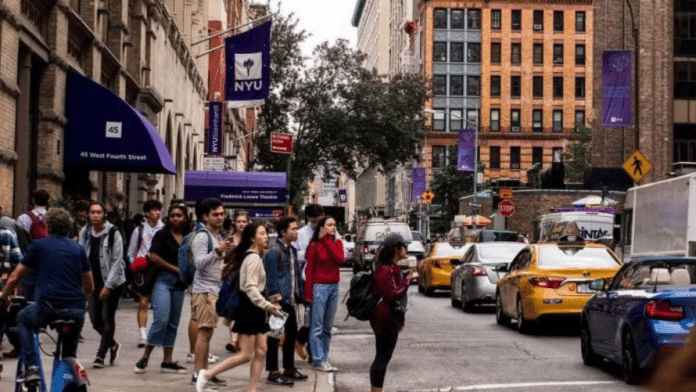New Delhi: Amid ongoing visa uncertainties in the US, the latest Open Doors 2025 report, which provides early trends for the 2025-26 academic year, shows a sharp 17 percent decline in new international student enrollments in fall 2025, following a 7 percent drop in fall 2024.
Despite the overall drop this fall, India retained its position as the top source of international students for the second consecutive year in the academic year 2024-25, surpassing China, according to the report published annually by the Institute of International Education (IIE), the leading source of data on international students in the US and US students studying abroad.
According to the report, colleges and universities cite multiple contributing factors behind the decline in new enrollments in the fall 2025, with 96 percent of institutions mentioning visa application concerns and 68 percent highlighting travel restrictions.
The report states that for India, the top sender of international students whose numbers soared post-pandemic, the majority of institutions report new enrollment declines, with only 39 percent noting increased or stable numbers.
The data indicate that the decline is most pronounced among Indian students compared to all other international student groups.
“These declines in new enrollment from India are likely driving the overall national decrease. In contrast, most institutions report that new international student enrollment from China (56 percent) and South Korea (’60 percent’), the second- and third-leading senders of international students, remained stable or increased in the fall of 2025,” the report states.
The report released Monday shows that 3,63,019 Indian students were enrolled in the US in 2024-25, up 10 percent from 3,31,602 in the previous year. Indians accounted for 30.8 percent of 1,177,766 international students.
China followed with 2,65,919 students, a 4 percent decline from 2023-24, marking their lowest student enrollment in US institutes in at least the past eight years.
In 2023-24, India became the largest source of international students in the US, surpassing China for the first time in 15 years.
Together, India and China accounted for 53.4 percent of all international students in the US in 2024-25. The other top countries were South Korea (42,293), Canada (29,903), Taiwan (25,584) and Nepal (24,890).
The report notes that the total number of international students in the US rose 4 percent in 2024-25 to 1,177,766 from 1,126,690 in 2023-24.
However, the number of new international students—those enrolling in a US-based college or university for the first time in fall 2024—fell by 7 percent to 2,77,118 from 2,98,705 in the previous year.
“This varied by academic level–the number of new undergraduates grew by 5 percent, while the number of new graduate students fell by 15 percent,” the report stated.
It also provided a fall 2025 “snapshot” of international student enrollment, offering early trends for the 2025-26 academic year. Over 825 US higher education institutions participated, providing an initial look at student numbers, the report stated.
“New international student enrollments—those studying in the US for the first time—dropped 17 percent. Many institutions continue to focus on international student recruitment, recognizing their value both for the diversity of perspectives they bring to campus and their financial contributions,” the report noted, citing that 81 percent of institutions highlighted students’ perspectives and 60 percent emphasised their economic impact.
Under the Donald Trump administration, stricter visa rules and social media screening policies have created visa uncertainties for international students.
Across all academic levels, more than half, or 57 percent, of international students pursued STEM fields in 2024-25, reflecting continued demand for science, technology, engineering, and math education in the US. Overall, international students accounted for 6.1 percent of the total US higher education population of 19,247,640 students in 2024-25.
Also Read: Draft ISI Bill 2025: India’s pre-eminent statistics institute caught in a tussle for autonomy
Drop in visa to Indians in fiscal year 2024
The report also highlighted significant shifts in visa issuance. While the number of Indian students in the US has increased, the report shows a 33.2 percent decline in F visas—a non-immigrant visa for students studying full-time at US institutions—issued to Indian students in the fiscal year 2024 compared to fiscal year 2023.
The US fiscal year runs from 1 October to 30 September. This means the comparison is between 1 October 2022–30 September 2023 and 1 October 2023–30 September 2024. However, it also captures the early figures for the 2024-25 academic session, which begins between August and September.
Similarly, M visa issuance—a non-immigrant visa for students in vocational or non-academic programmes—dropped 18.2 percent, while J visa issuance—a non-immigrant visa for exchange visitors in cultural and educational programmes—declined by 1.7 percent during the same period.
For Chinese students, F visa issuance fell 3.6 percent, while M visa issuance rose 33.6 percent and J visa issuance increased 10.9 percent. Similarly, for South Korean students, F visa issuance declined by 8.9 percent, M visas fell 5.7 percent, while J visas increased 5.6 percent in 2024-25.
This is an updated version of the report with additional inputs on contributing factors behind the decline in new enrollments.
(Edited by Sugita Katyal)
Also Read: Despite lower rank, IIT-Delhi retains spot as top Indian university in QS World Rankings (Asia)






